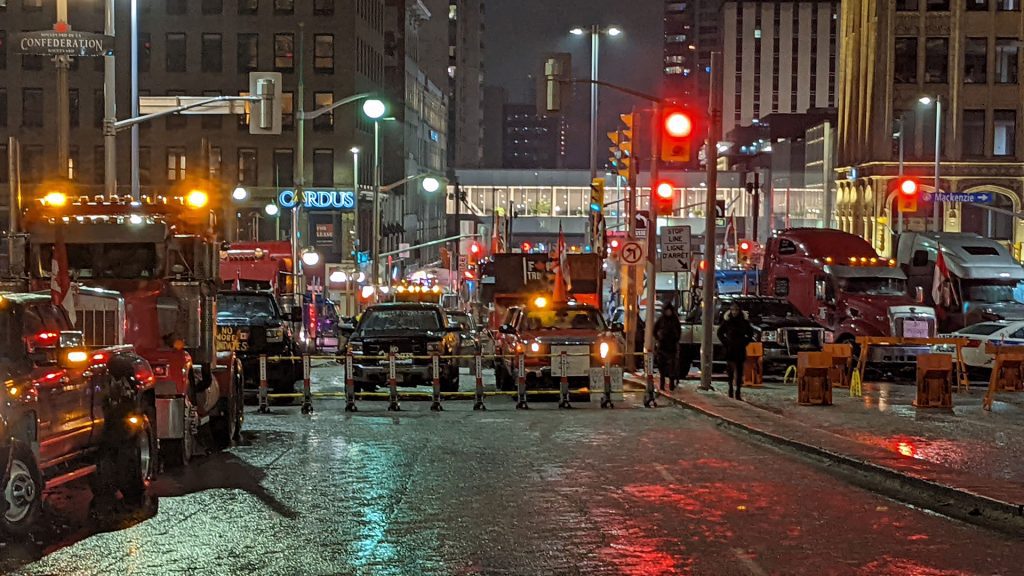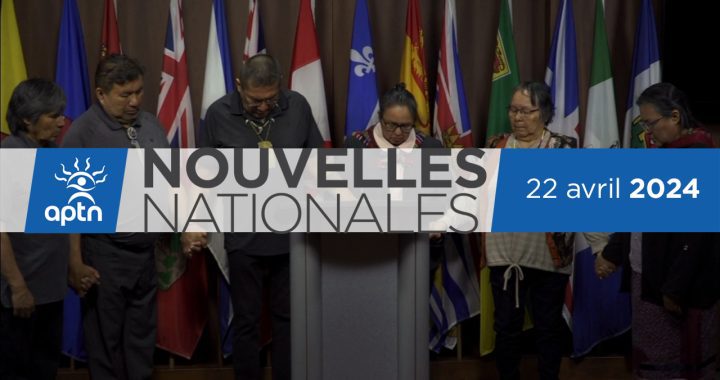
A line of trucks block in downtown Ottawa block access to Parliament Hill. Photo: Mark Blackburn/APTN.
An Inuit organization in Ottawa that provides a number of services to Inuit in the city says the truckers protest “has introduced a high-level anxiety and increased fear” for its clients and Indigenous communities in the national capital area.
“Today, we add our support to the Algonquins of Pikwaknagan, Kitigan Zibi and the Algonquin Nation Tribal Council in opposition to the “Freedom Convoy Protest” using cultural practices of Indigenous people in ceremonies,” says a statement released by Tungasuvvingat Inuit, better known in the area as TI.
“TI believes in the right to peaceful protests however, the protest in downtown Ottawa have introduced a high-level anxiety and increased fear for the vulnerable Indigenous communities in the area. By virtue of the ongoing blockades and volume of protestors and trucks, this demonstration has impeded TI’s ability to provide critical programming and services to urban Inuit.
“In a period with recent extreme cold warnings, the ongoing health crisis, the emergency housing crisis and food security issues, the protest is negatively impacting those vulnerable members of our community.”
Since the weekend, hundreds of trucks and protesters have clogged Ottawa’s downtown core in front of Parliament Hill – but also in neighbourhood communities. Some residents say the trucks idle throughout the night and horn blasts can be heard at all hours.
Much of the core centre of downtown has been closed off by police because of the trucks blocking major thoroughfares through the area.
Ottawa sits on the traditional territory of the Algonquin peoples. On Wednesday, a joint statement was released by the Algonquin Nation condemning the truckers convoy and a ceremony that was held in a downtown park.
“The actions that are taking place on our Territory (Ottawa, ON) is unacceptable,” the statement says. “For those who are participating in these actions, the Algonquin Nation does not support the set up of a teepee, the pipe ceremony and sacred fire in Confederation Park in support of the “Freedom Convoy.
“The Algonquin Nation did not give consent to these ceremonial practices and could cause more harm to who we are as First Nations/Algonquin peoples. First Nations and Non-Indigenous people should always remember protocol and that permission from us is needed to proceed.”
One of the participants in the ceremony was protest organizer Pat King who apologized in a youtube video on Feb. 2.
He’s one of the many organizers who say the people here “are exercising our right to a peaceful protest and we are peaceful.”
Press Release – February 3, 2022, OTTAWA, ON.
TUNGASUVVINGAT INUIT STATEMENT – TRUCKER PROTEST EFFECT ON VULNERABLE COMMUNITY IN DOWNTOWN OTTAWA
Read more: https://t.co/nEtag2rWAO
— Tungasuvvingat Inuit (@TIOntario) February 3, 2022
But not everyone is describing the protest as peaceful. While there have been few arrests, local residents have complained about idling trucks, fumes, and the constant blowing of horns.
“The protest was positioned as a peaceful but, has turned into large intimidating crowds threatening the safety of vulnerable individuals that require supports from service and program providers in downtown Ottawa,” TI says in the statement
“There is an increased level of concern shared amongst service providers and clients following incidents that included harassment of shelter services workers, demand for food intended for food-insecure individuals, the inability to reach vulnerable community members requiring urgent supports, blocking access for services providers to help the vulnerable, impacting the sheltering system for women and homeless and the intimidating presence and ongoing noise.”
There are now rumours that the second wave of protest is scheduled for downtown Ottawa this coming weekend.
Read more:
Soft police approach to Ottawa anti-vax protest reveals ‘pure racism’ say critics
At a briefing with Ottawa city councillors on Wednesday, Police Chief Peter Sloly seemed to throw up his hands and suggest that law enforcement may, in the end, have a limited role in resolving this protest.
Sloly said “all options are on the table,” including calling in the military. The word “occupation” is now being used to describe what is happening downtown.
Sloly said ending the protest, which rolled into the city as a convoy last Friday, could come through negotiations or it could come through police enforcement.
“All such options come with significant risks,” Sloly said at the meeting.
Here is a scene from the protest on Wellington St. outside the Prime Minister’s Office:
Police estimated the protest involved 8,000 to 15,000 people on Saturday but has since dwindled to several hundred.
For residents, businesses and organizations like TI, there is one request.
“We respectfully ask that the protestors remove themselves from Ottawa. It is time to go home and allow for our vulnerable urban Indigenous communities to feel safe again and regain access to cultural programming and essential services,” Tungasuvvingat Inuit says.
At a short news conference, the leaders of the truckers protest said that the protest has in fact been peaceful, and cleaning up the downtown core and serving food to people on the streets. The leaders only answered two questions before abruptly leaving the meeting room.
With files from the Canadian Press









